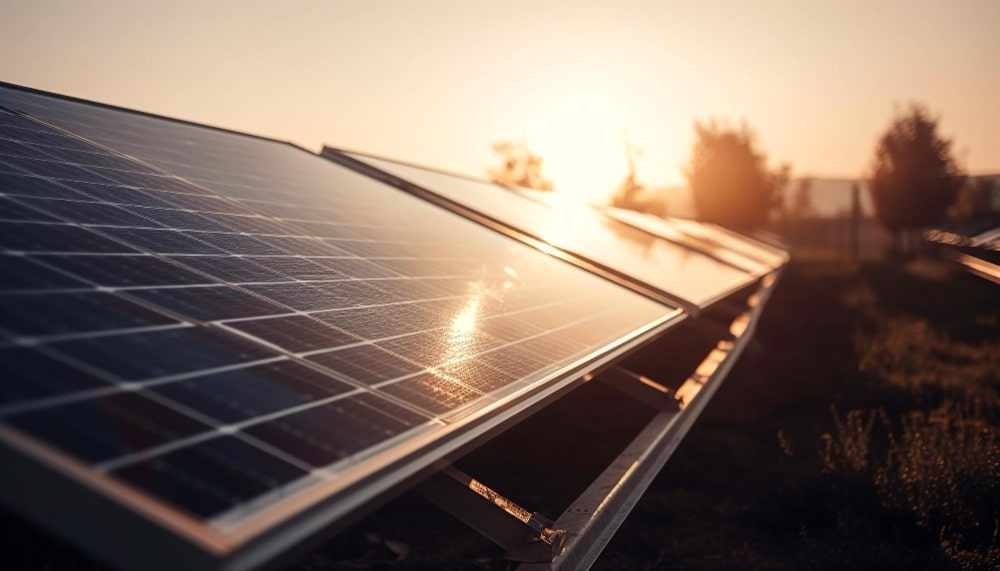Imagine harnessing the sun’s power to heat your home’s water, reducing your energy bills and carbon footprint. Solar water heating systems make this a reality, providing a sustainable and efficient way to heat your water. This blog post will explore the ins and outs of solar water heating systems, helping you decide about this fantastic renewable energy technology.
We will delve into the components of solar water heating systems, the types of solar thermal panels, factors to consider when choosing a system, costs and potential savings, and installation and maintenance tips. By the end of this post, you will have a comprehensive understanding of how solar water heating can benefit you and the environment.
Key Takeaways
- Solar water heating systems offer an efficient, renewable and cost-effective way to save money while reducing energy bills and carbon emissions.
- Investing in solar water heating can lead to substantial savings and financial incentives such as the Renewable Heat Incentive (RHI).
- Research and comparison of installers is key for homeowners looking to maximize their benefits from renewable energy.
Understanding Solar Water Heating Systems
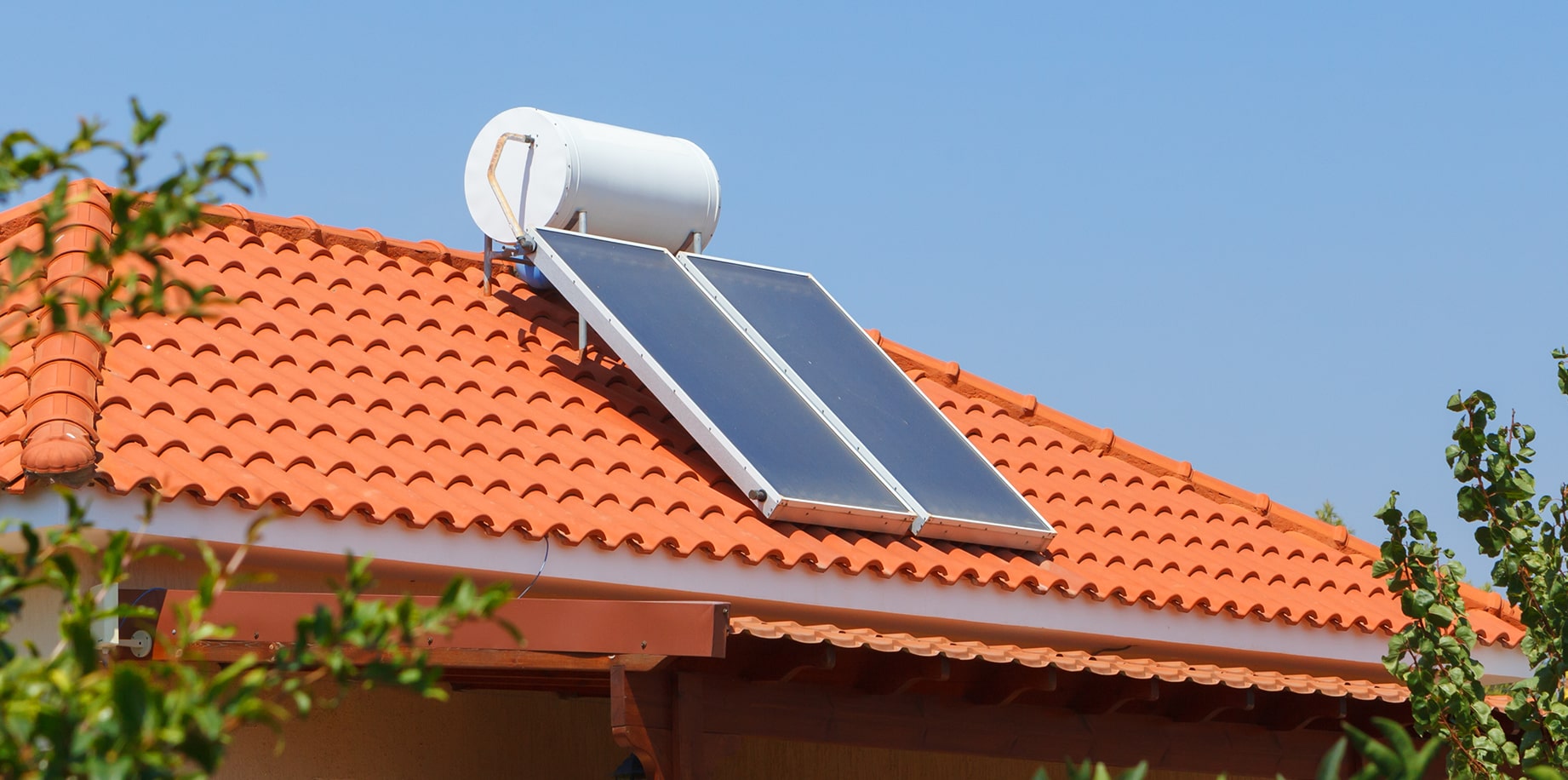
Solar water heating systems represent an innovative approach to harnessing the sun’s energy to meet your home’s hot water needs. By using solar collectors, these systems convert the sun’s rays into heat, providing a renewable and efficient way to reduce your energy bills. Besides their eco-friendly advantage, these systems also offer significant energy-saving savings.
A solar water heating system comprises a solar collector, a cylinder or tank to store solar-heated water, and a controller to manage the system optimally. These solar hot water systems are an excellent way to provide hot water for your home while minimising carbon emissions and energy costs.
Flat plate and evacuated tube collectors are the two main types of solar thermal panels, each with advantages and disadvantages.
Components of a Solar Water Heating System
A solar water heater setup, which includes solar water heaters, comprises efficient solar collectors, a robust storage tank, and an effective heat transfer mechanism. These thermal systems leverage the sun’s rays to meet your household’s hot water needs in an eco-friendly manner.
The essential components of a solar water heating system include:
- Solar collectors
- Heat transfer fluids
- Water storage tanks
- Circulation pumps
- Connecting pipes
- A controller
- Valves
All of these components work together to make the system highly efficient. Solar PV panels, on the other hand, generate electricity rather than heat water, making them a separate renewable energy technology.
How Solar Water Heating Works
By employing solar thermal panels, these solar thermal systems absorb sunlight and convert it into heat, which is then transferred to a fluid that efficiently heats the stored water. Such a system can remarkably cater to up to 70% of a four-member family’s annual hot water needs, offering an eco-friendly and economical solution.
The components of a solar water heating system include:
- Solar thermal panels absorb sunlight and transfer heat to a fluid
- Fluid: heats water stored in a cylinder
- Controller: regulates the system
- Pump: circulates the fluid
- Cylinder: holds the heated water
An immersion heater or unvented hot water cylinder could be a great reliable backup heater. It can quickly and effectively heat the water to the desired temperature.
The number of solar panels or tubes needed for a household depends on the household and hot water use, with 1 square meter per person for flat panels and 20 or 30 tubes for tube collectors. The installer must judge the hot water requirements properly to ensure optimum performance. The panel and cylinder must be sized accordingly.
Types of Solar Thermal Panels: Flat Plate vs. Evacuated Tubes
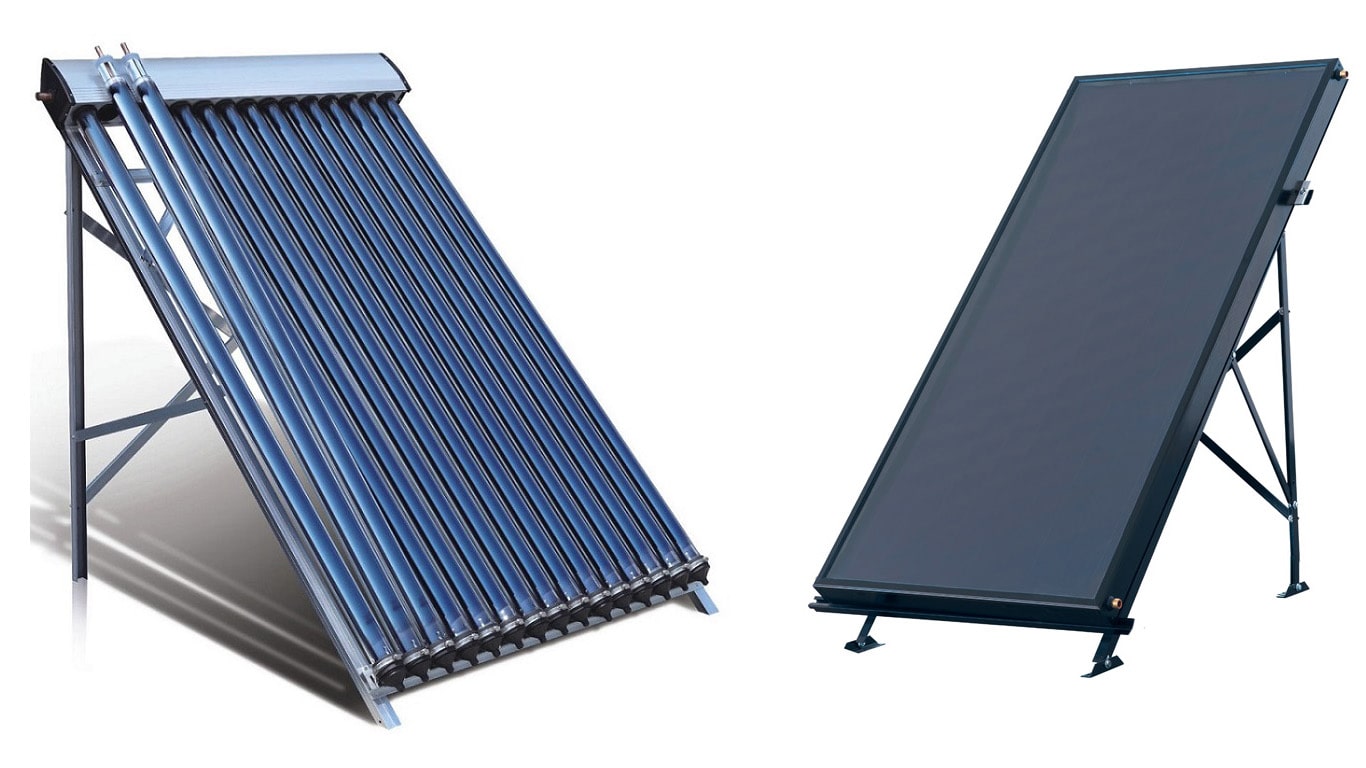
Flat plate collectors are cost-effective, simple to install, and require minimal upkeep. On the other hand, evacuated tube collectors boast increased efficiency in hotter climates and enhanced resistance to hail and debris.
Each type of solar thermal collector has advantages and disadvantages, making the choice between flat plate and evacuated tube collectors dependent on location, climate, and budget. In the following sections, we will delve into the specific features of flat plate and evacuated tube collectors, helping you decide which type of solar thermal panel is best suited for your needs.
Flat Plate Collectors
Flat plate collectors are incredibly efficient solar thermal panels with a flat, glazed, dark-surfaced absorber plate containing metal tubing, making them an excellent choice for renewable energy. The fluid is heated up by the solar power captured from the sun, making flat plate collectors a highly efficient way of harnessing the sun’s energy.
Flat plate collectors are an economical, low-maintenance solution that performs similarly to traditional solar panels. Evacuated tube collectors are even more efficient, making them an excellent option for those willing to invest in a higher-quality product.
When selecting a flat plate collector, it is important to consider the size of the collector, the type of fluid used, the climate, and the cost.
Evacuated Tube Collectors
Evacuated tube collectors are incredibly efficient solar water heating panels that use vacuum-sealed tubes to transfer heat to a fluid, making them an excellent choice for sustainable energy. There are two types of evacuated tube collectors: Direct Flow and Heat Pipes, which are highly efficient and effective.
Evacuated tube collectors are widely considered the more efficient option than flat plate collectors. They are more cost-effective in the long term and require minimal maintenance.
When considering evacuated tube collectors for your solar water heating system, factors such as location, climate, and budget should ensure you make the best choice.
Factors to Consider When Choosing a Solar Water Heating System
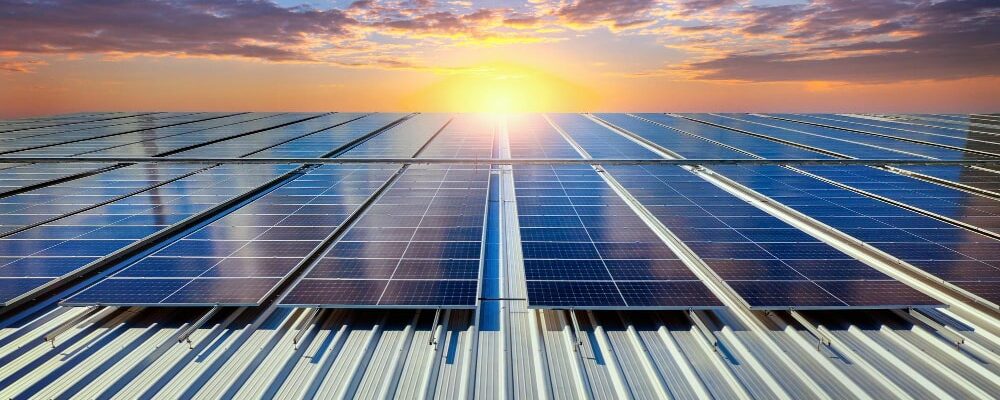
When opting for a solar water heating setup, several factors must be considered for optimal performance and efficiency. Elements such as:
- Panel efficiency
- System components
- Panel placement
- Your household’s hot water demand
For example, if you have a combi boiler and no hot water tank, you should check what extra equipment you’ll need and how much it will cost, as this may affect the compatibility of your boiler with a solar water heating system. The recommended panel area per person for a solar water heating system is approximately one to two square meters, ideal for households.
Properly considering these factors can help you make the best decision when choosing a solar water heating system for your home.
Costs and Savings Associated with Solar Water Heating
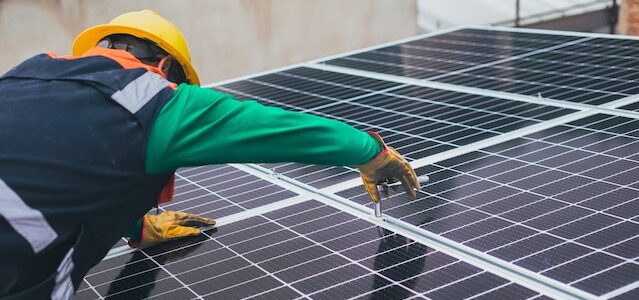
Solar water heating systems have associated costs for installation and maintenance but can result in significant savings and financial incentives as solar water heating works effectively.
In the following sections, we will explore the costs of installing and maintaining a solar water heating system and the potential savings and financial incentives available to homeowners who choose to invest in this renewable energy technology.
Installation Costs
The installation costs for solar water heating systems vary depending on system size, complexity, and location. A roof-mounted solar water heating system can range from £3,000 to £6,000.
Gathering quotes from multiple solar installers is one of the most effective ways to reduce the total cost of your new solar hot water system. Doing this will ensure that you pay the best price for proper installation. This can help you find the best deal and ensure you get the most value for your investment.
Additionally, grants or financial incentives may be available to help offset the cost of installing a solar water heating system. Check with your local authority or the Energy Saving Trust to see if you qualify for grants or funding.
Maintenance Costs
Maintenance costs for solar water heating systems are generally low, with periodic check-ups every 3-7 years to keep anti-freeze fluid and other components in optimal condition. On average, servicing costs are around £75.00 including VAT, which is an excellent value for your investment.
It’s important to ensure that you check for leaks and replace anti-freeze and pumps as needed to maintain the efficiency of your solar water heating system. Regular maintenance can help extend the life of your system and maximize the savings you can achieve by using solar water heating.
Potential Savings and Financial Incentives
The potential savings from solar water heating depend on the type of system being replaced. A family can benefit up to £180 or more annually with a solar water heating system that replaces a gas boiler. If solar water heating replaces direct electric heating, then the benefit for a family should be well over £500 per year.
In addition to the savings on energy bills, financial incentives are available for homeowners who invest in solar water heating systems. The Renewable Heat Incentive (RHI) is a government scheme that rewards homeowners with an excellent incentive for using low-carbon heating systems. By participating in the RHI, homeowners can receive payments for the renewable heat generated by their solar water heating systems, further increasing the financial benefits of investing in this renewable energy technology.
Solar Water Heating for Swimming Pools and Other Applications
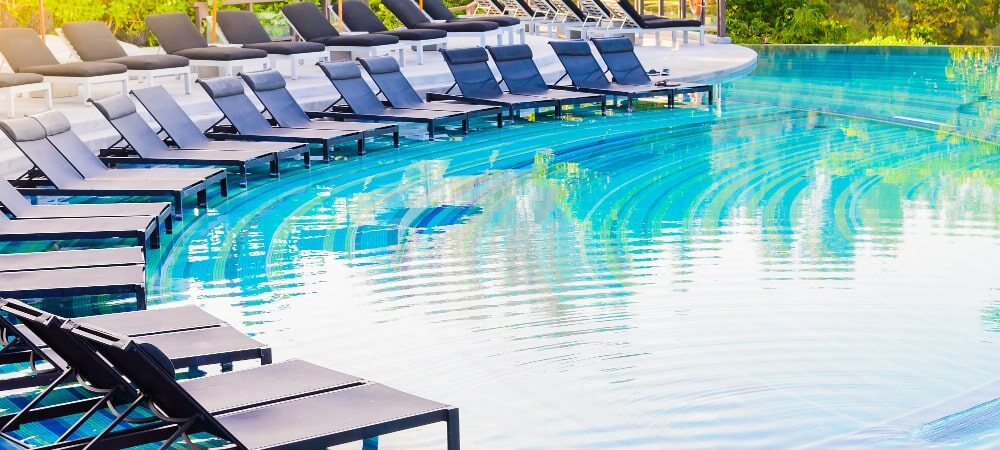
Solar water heating isn’t just for household hot water needs; it can also be used for swimming pools, reducing energy consumption and expenses by circulating pool water through solar collectors to heat it before returning it to the pool. Solar thermal heating for swimming pools works efficiently by pumping filtered pool water to the solar collectors to be heated, cooled, and pumped back into the pool, helping maintain the desired water temperature.
In addition to swimming pools, solar water heating systems can be utilized for various other applications, such as radiant floor heating, industrial process heating, and space heating. The versatility of solar water heating systems makes them an excellent investment for those looking to reduce their energy consumption and embrace renewable energy in their daily lives.
Finding a Reputable Solar Water Heating Installer
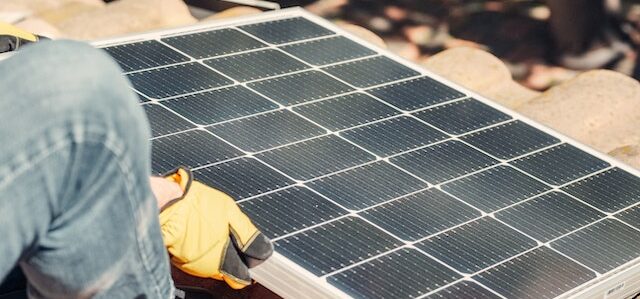
When seeking a trustworthy solar water heating installer, it’s beneficial to:
- Gather multiple quotes from certified installers
- Consult dependable sources such as professional bodies and peer-reviewed platforms
- Use the Microgeneration Certification Scheme (MCS) website to find certified installers
- Use Which? Trusted Traders for independent, impartial advice to help you find the right solar panel installer. They provide assurance that they are safe, reliable, and trustworthy.
Another fantastic opportunity to find solar thermal quotes is through GreenMatch, which allows you to get up to 3 different solar thermal quotes, allowing you to compare and make the best choice for your needs easily. By taking the time to research and compare installers, you can ensure that you find the best installer for your solar water heating system, maximizing the benefits of this renewable energy technology.
Installation and Maintenance Tips for Solar Water Heating Systems
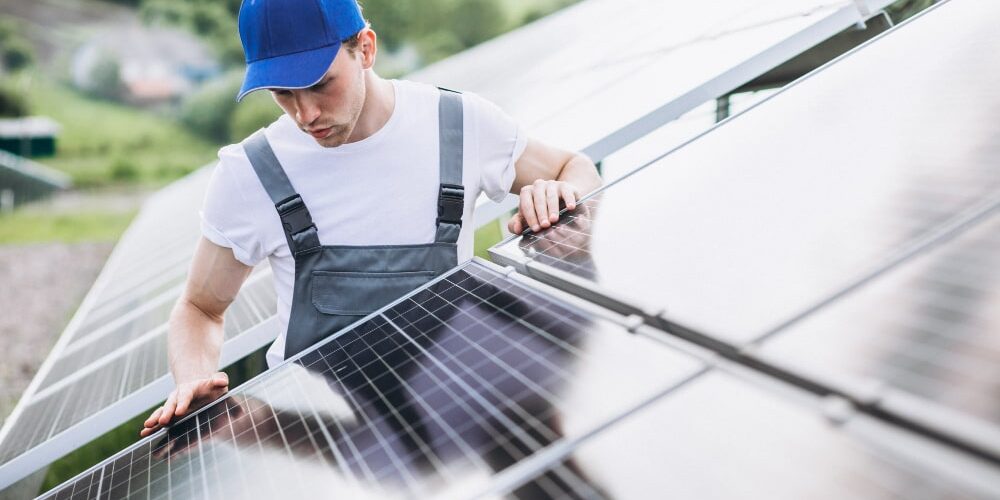
Appropriate installation and upkeep of solar water heating systems can optimize efficiency and savings. Considerations like panel location, system components, and household hot water demand are key to optimal performance during installation. Moreover, conserving hot water, performing regular leak checks, and promptly replacing anti-freeze pumps are vital for maintaining system efficiency.
By following these installation and maintenance tips, you can ensure that your solar water heating system operates at peak efficiency, helping you save money on your energy bills and reduce your carbon footprint. As the popularity of renewable energy technologies continues to grow, solar water heating systems offer a fantastic opportunity for homeowners to embrace a more sustainable and energy-efficient lifestyle.
Summary
In conclusion, solar water heating systems provide an efficient and sustainable way to heat your home’s water using the sun’s energy. With various types of solar thermal panels, such as flat plate collectors and evacuated tube collectors, homeowners can choose the best system for their needs. By considering factors such as panel efficiency, system components, panel location, and household hot water demand, you can ensure optimal performance and savings from your solar water heating system.
As the demand for renewable energy solutions continues to grow, solar water heating systems offer a fantastic opportunity for homeowners to reduce their energy consumption, lower their energy bills, and contribute to a greener future. By investing in a solar water heating system, you can enjoy the benefits of this innovative technology and positively impact the environment.
Frequently Asked Questions
Is solar water heating worth it?
Solar water heating is an excellent and cost-effective option for households switching from gas and hydropower. With the right setup, homeowners can save up to 80% on water heating costs, making it a great investment in the long run. Installing a solar water heating system is relatively straightforward and can be done by a professional or DIY enthusiast. The system comprises a solar collector, a storage tank, and a circulation system.
What are the disadvantages of solar water heating?
Solar water heating has several disadvantages, including the need for expensive upfront installation costs, the need for proper roof space, the lack of functionality on cloudy days, and necessary maintenance costs. Additionally, it needs direct sunlight to function and requires installing a new hot water cylinder.
Can solar water heaters heat the house?
Solar water heaters can contribute to heating your home, but the heat provided is usually less than 10% of the total home heating requirement. As such, using other methods for heating your house is best.
Is there a solar-powered heater?
Yes, there is a solar-powered heater available on the market. For instance, Jackery Solar Generator 1000 Pro, Solar Air Heaters and Solar Infra Systems’ Portable Interior/Exterior Heater all use thermal energy from solar collectors to generate heat.
What are the differences between flat plate collectors and evacuated tube collectors?
Flat plate collectors are cost-effective and straightforward to install, while evacuated tube collectors offer increased efficiency in hotter climates and more durability against hail and debris.
